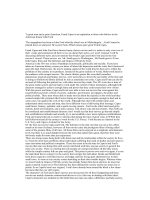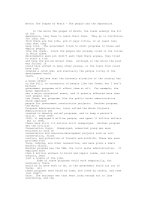grapes of wrath and of mice and men character study
Bạn đang xem bản rút gọn của tài liệu. Xem và tải ngay bản đầy đủ của tài liệu tại đây (29.72 KB, 2 trang )
The American Novelist, John Steinbeck was a powerful writer of
dramatic stories about good versus bad. His own views on writing were
that not only should a writer make the story sound good but also the story
written should teach a lesson. In fact, Steinbeck focused many of his
novels, not on average literary themes rather he tended to relay
messages about the many hard truths of life in The United States. Upon
winning the Nobel Peace Prize in 1962 the Swedish academy introduced
him by saying "He had no mind to be an unoffending comforter and
entertainer. Instead, the topics he chose were serious and
denunciatory " This serious focus was not exempt from his two works
"The Grapes of Wrath" and "Of Mice and Men". "The Grapes of Wrath"
has been recognized by many as "the greatest novel in American History"
and it remains among the archetypes of American culture. Although "Of
Mice and Men" may not have received as much fanfare as the other it is
still a great classic that was recently made into a motion picture. The
focus of "The Grapes of Wrath" Is one family, the Joads, who has been
kicked off their Oklahoma farm and forced to move to California to look
for work. The story has historical significance as it is true that many
families were forced, in the same way as the Joads, to leave their homes
to look for work during the depression. It is in this fact that one can see
how Steinbeck's intention in "The grapes of Wrath" was to depict the
hardships people went through during an actual event in American
history. Perhaps the most solemn message in this novel was the poor
treatment of the dispossessed families as they reached California. In "Of
Mice and Men" the reader is presented with a story that takes place in the
same setting of "The Grapes of Wrath" This story details the hardships of
two traveling companions while they are working at a ranch in California.
The common thread between these two novels is not necessarily
the plot or the setting rather, it is the way in which Steinbeck relays his
message. That is to say that, although both novels carry different story
lines they both portray hard truths about human suffering. Steinbeck
reveals these truths through his depiction of characters. In each story it
seems that the characters were crafted by Steinbeck in a bias manner so
as to emphasize the overall message of the book. It is quite obvious that
all of Steinbeck's characters are either good or bad. Steinbeck himself
said "as with all retold tales that are in people's heart's there are only
good and bad things and black and white things and no in-between
anywhere" In both novels the dispossessed characters are good and well
intentioned and the wealthy people are brutal and mean. This of course
is done to make the situation seem all that more hard on the
dispossessed characters. In "The Grapes of Wrath" the character of
young Tom Joad is a prime example of how bias Steinbeck's portrayal
was. With a quick glance at the history of Tom's life one would say that
he is not really the good guy. Yet after reading "The Grapes of Wrath"
the reader feels sorry for Tom and all of his faults are justified because of
his situation. Likewise, the characters of Ma and the preacher, Jim Casey
do not fit their traditional roles but, again, their actions are justified by
Steinbeck. In the same way, the book "Of Mice and Men" portrays two
men (Lennie and George) running from the law, looking for work. Lennie
is a mentally handicap person who brings most of the trouble to the pair.
Yet, despite all of his downsides the reader is made to feel sorry for him.
George is portrayed in a good way until the end of the book where he kills
Lennie, and even then the reader feels for George because of the
predicament he is in. The rest of the characters in both novels are the
rich and powerful. In "The grapes of Wrath" these rich people were not
even given names and Steinbeck's dislike for them is obvious. This fact
truly illustrates the message he is trying to get across . In "Of mice and
Men" the boss and his son Curley are portrayed as the bad
guys.Note:This is only my introduction unfortunately due to some
extenuating circumstances I have not had enough time to do a complete
rough draft. My plan is to characterize the characters in light of
Steinbeck's bias portrayals and illustrate how the technique he used was
effective in getting his point across. My next four points or paragraphs
will be: 1.) Description of Tom Joad how he was bad yet good in the
sense that his actions were bad but his cause was for the better.2.)
Description of Ma and the preacher, how they were characterized out of
their traditional roles and how their straying form the norm was justified
and helped relay to the reader the desperation of the family's situation.3.)
The roles of Lennie and George, how they were outcasts and Lennie
killed a women yet the reader felt sorry for them both because they were
on the opposite side of a greater injustice.4.) Portrait of the rich and
powerful. How Steinbeck's ignorance of not giving them names proved
he did not like them. Every time they came up in the story they were
doing something bad.And my conclusion. Hopefully I will get a chance to
see you today, I have third period prep so I will look for you and we could
chat. Thanx. "The Grapes of Wrath", "Of Mice and Men"Character
Study Max RaffoulENG OACMarch 3, 1997Mr. Chevallier









